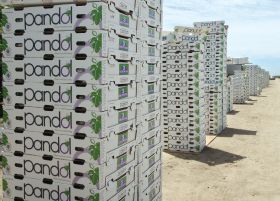
John Pandol of Pandol Bros takes a look at the prospects for the new California table grape season updates Americafruit on the latest varietal developments at the Delano-based marketer.
How is the US table grape market looking right now? Are you anticipating a smooth transition from Southern to Northern Hemisphere supplies given the earlier than usual end to the Chilean deal?
JP: Chile has shipped significantly fewer grapes than usual this season. There have been years when we sold 20 per cent of our Chilean programme after May but this year it’s been more like 2 per cent. Coldstores have never been this empty at this time of the season. Retail sales have been slower and discounting of red seedless varieties by importers began after Easter. Last year several sellers were buried with Chilean and dessert red grapes and had very low returns. The good quality green seedless volumes that are currently available are very expensive and there is a full range of prices depending on the condition of the fruit.
 Does this mean that prices are likely to remain firm throughout May and early June?
Does this mean that prices are likely to remain firm throughout May and early June?
JP: At total weekly volume up to 3m cartons, prices can be stable as long as enough business has been booked to keep the flow going. If purchase slows down at retail or marketers fail to sufficiently pre-book business, prices can be all over the board real fast.
What is the outlook for Mexican grapes this year? I understand volumes are down – is this across all varieties?
JP: As expected after a low chill winter, yields are down across the board. We’re seeing an adequate number of bunches that are not as large as normal, and that accounts for most of the variance. One can never predict berry size as it develops very late in the harvest cycle but based on my observation of my growers most will have large berries, a few will have jumbos and a few will find homes with value customers.
What about the California grape harvest? How is this shaping up for the main varieties?Has the water shortage had any impact on this year’s crop?
JP: The California crop will be similar in terms of output, in spite of the reduction in acreage. The lack of water allocation has accelerated old vineyards, low producing vineyards and obsolete varieties. Crimson will decline a little, Flames and Scarlet Royal are likely to remain stable, Autumn King will increase, and Thompson and Sugraone will decline due to a significant amount of vineyards being removed.
Given that California and Mexico are likely to have an earlier than usual finish this year, where does this leave you in terms of your end-of-season programmes? Do you foresee a shortage and if so, how will you fill the gap?
JP: The desert grapes which generally run from early May through to mid-July will start early and end early. Central California will start early as well so there will be no gap on the front end. How many grapes we will pick in November and December remains to be seen, but in all my years California has never been shipped out by the end of the year. With regard to programmes, most of our customers now know that grapes are not necessarily available 52 weeks a year. That is an artificial concept imported from the CPG category management model which has forced the industry to pick too early, store too long and plant grapes in locations that have less than optimum growing conditions. US consumers and retailers have rediscovered seasonality – grapes may always be on the shelf, but they are better at certain times of the year.
Will there be any significant change to your grape programmes for the US this year?
JP: For us we will have an increase in availability of late whites (both Autumn King and Luisco), as well as a big increase in midseason Sweet Celebration, and an increased amount of a white prototype called Sugar Crunch. If the production issues get worked out, then we will start planting the first commercial volumes of this variety.
What else is new in Pandol's grape business?
JP: We’ve replaced our low quality polyethelyne bags made with high-recycled content with clear high quality laminated polypropeleyne bags.
Is Sweet Celebration proving to be a hit with US consumers? What other proprietary varieties are set for development?
JP: Pandol has had good consumer success with Sweet Celebration, harvesting a large, bright tasty grape that is truly seedless or very close to true seedless. Not all growers of this variety have produced the same result, especially with regard to the absence of seeds, and this has been a problem in the marketplace. In California we’re seeing much more planting of public varieties than proprietary ones. The key problem with proprietary varieties is that because they are in few hands, very little experimentation goes on.






No comments yet